Are you looking to get a flogger, but have no idea where to go or what to look for? If so, this page will help you get familiarized with the options you have available.
Where to Buy Floggers
Most people I direct to this page asked where to buy a flogger, so let’s get that out of the way first. Click here to see the infamous list I’ve compiled of shops who take online orders. The spreadsheet emphasizes finger floggers, as many brick-and-mortar kink stores don’t carry those. It’s not comprehensive by any means, but will hopefully get you off to a pretty thorough start. The list is also localized to shops in the United States and Canada (and a couple in the United Kingdom). I apologize if you’re outside these countries, but I simply don’t know enough about kink scenes globally to feel comfortable sharing resources.
If you’re looking for more information than just where to buy floggers, please keep reading, as I go into pretty excruciating detail below on the different types of floggers out there, as well as all the components that make up floggers and why these components are important …
Handle Types
Probably the first big decision you’ll make when getting a flogger is which type of handle to go with. There are several different types, and all of them have their advantages and disadvantages, which I’ll go through below.
Traditional Handled Floggers

Handled floggers feel the most natural, since handles are … well, a pretty universal part of human tools. They are the easiest to control and thus safer to throw when first learning.
Finger Floggers
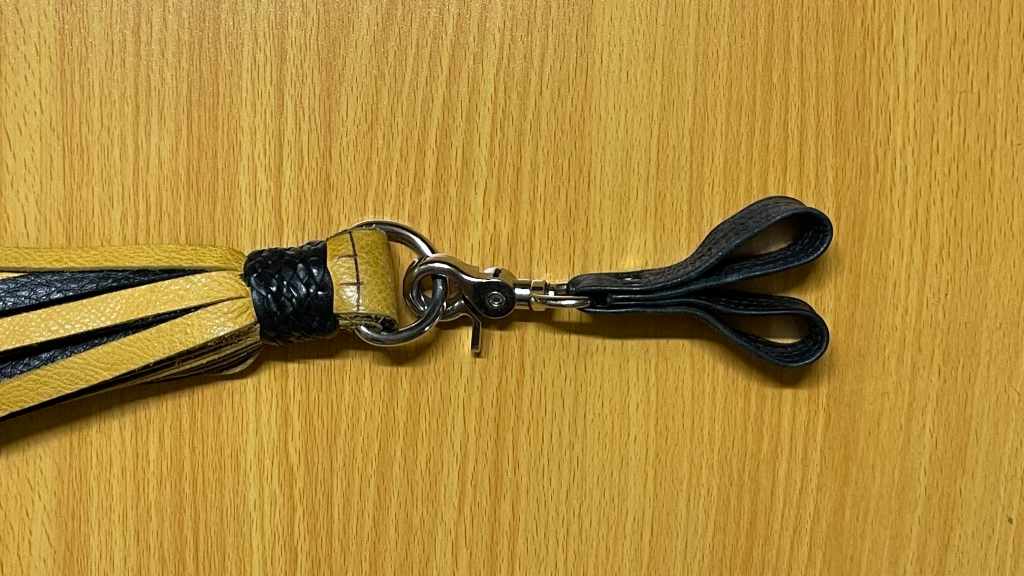
Finger floggers, also called poi floggers, have two finger loops, which you stick your two chosen fingers through. Some people prefer index and middle fingers, other people prefer middle and ring fingers. There’s really no right or wrong way to hold them. It’s just whatever feels most comfortable and practical for you. (So probably not ring and pinky fingers then … unless you just wanna show off in weird ways, you degenerate you …)
Finger floggers may feel like a completely foreign beast at first, and throwing them with any amount of control will take time to learn. On the other hand, once you develop your accuracy (hitting exactly where you want to) and precision (hitting the same spot over and over again), you can throw finger floggers way harder and faster, and from angles that you just can’t with handled floggers. Finger floggers are also easier on the wrist.
Some finger floggers have swivels, which allow you to literally spin them. Swivel floggers are the most difficult to control, but they will open up a world of moves that you could never dream of pulling off with handled floggers. If you’re wondering what these moves are … umm, this entire website is basically dedicated to teaching you how to wield finger floggers, so … you know, browse away.
Swivels are a super-important component of finger floggers, so I’ll get stupidly in-depth with them in the next section.
T- and Ball-Handle Floggers

Falling between handles and finger loops, T- and ball-handles offer some of the versatility of finger loops along with the stability of traditional handles. They don’t allow as wide a range of movements as with swivel finger loops, but you may find them to be a comfortable compromise between handled and finger floggers.
At this point in our kink adventures, 90% of our arsenal is swivel finger floggers, and the rest have traditional handles. I even have swivel finger dragon tails, which can deliver sensations unlike any other impact toy you’ll find. Plus, if you like to show off as a top, they make this rapid-fire machine gun sound that will put everyone in the dungeon on notice.
These are just my personal biases, of course. You may decide to go with traditional or T/ball-handles, and they may suit you perfectly well.
Flogger Material
This page is already long enough as it is, I won’t get into the material the flogger tails are made of (cowhide, suede, nubuck, etc.). That decision is ultimately based on your personal preference. Plus, there’s already a ton of information available on the different materials and how they feel when they impact the skin.
The only comment I will make here is from a practicality perspective (because I am nothing but a practical person): unfinished leather, such as suede and nubuck, feels softer, but is much harder to clean than finished leather, which tends to be stingier. So you may want to consider how often you’re planning to use a toy when deciding on the material. You can always flog gentler with finished cowhide, but that suede is going to be a hassle to clean no matter what you do with it.
Swivels, Chains, and Metal Hardware
When you’re shopping around for a set of floggers, you may only be thinking about the material and the overall style, but don’t forget the importance of the metal hardware! The information in this section is going to get a little dry and technical, but there is a payoff at the end, I promise …
As mentioned above, swivels are a key enabler of our style. The metal ones you find in floggers are mass-manufactured products that can be purchased at any hardware store, but in this case, mass-manufactured equals stronger and more reliable. So … yay for that.
Trigger Snaps
Trigger snaps are spring-loaded rings that squeeze open to clip onto something, and they can come with swivels built in. Many flogger makers follow the same basic configuration for their finger floggers, where 1) the finger loops are attached to a trigger snap, and the trigger snap clamps over 2) a metal ring attached to the tails. When you have different floggers from different makers, but they all follow this same configuration, you can easily swap out your finger loops as desired (more on this below).
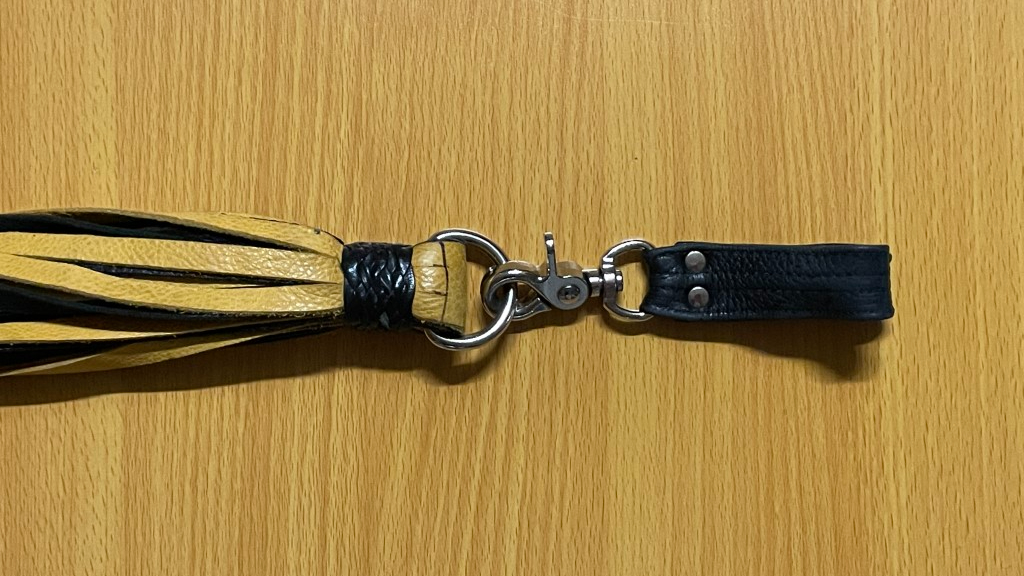
Trigger snaps come in all sizes and shapes, so I recommend inspecting them for strength and symmetry. A trigger snap that isn’t strong enough to handle the centrifugal forces generated by a spinning flogger can pull open in the middle of an intense scene. That’s … inconvenient, to say the least.
Also consider how symmetrical the trigger snap is. The two trigger snaps below look similar, but the one on the right is more symmetrical and will thus spin way more smoothly than the one on the left:

If you’re ordering floggers online, trigger snap symmetry is easy to pick out, but strength is more challenging. Generally speaking, if it looks like something you can find in a hardware store, you should be good to go. If it looks like something you can find in a crafts store, then take caution.
Other Swivel Types
Aside from trigger snaps, some floggers have eye-to-eye swivels, which don’t open and close. Yay for not accidentally pulling open! On the other hand, this means the finger loops and tails are permanently fastened together. With regular intense usage, the finger loops are inevitably the first point of failure, so non-removable finger loops means you’ll have to send the entire flogger back to the shop to get a finger loop replaced. Ugh.

Some flogger makers take swivels originally made for nunchaku (nunchucks) and repurpose them for floggers. These swivels use ball-bearings, so they provide for an extremely smooth spin. Nunchuck swivels are usually connected to the other end of the flogger using a quick link, a metal ring that screws open and closed. Quick links aren’t as easily swappable as trigger snaps, but they are far less likely to open up accidentally during hard flogging, since you can tighten them with a wrench.

Handled floggers with swivels are getting more common now as well. You can spin these like finger floggers while retaining some of the control of traditional handles.
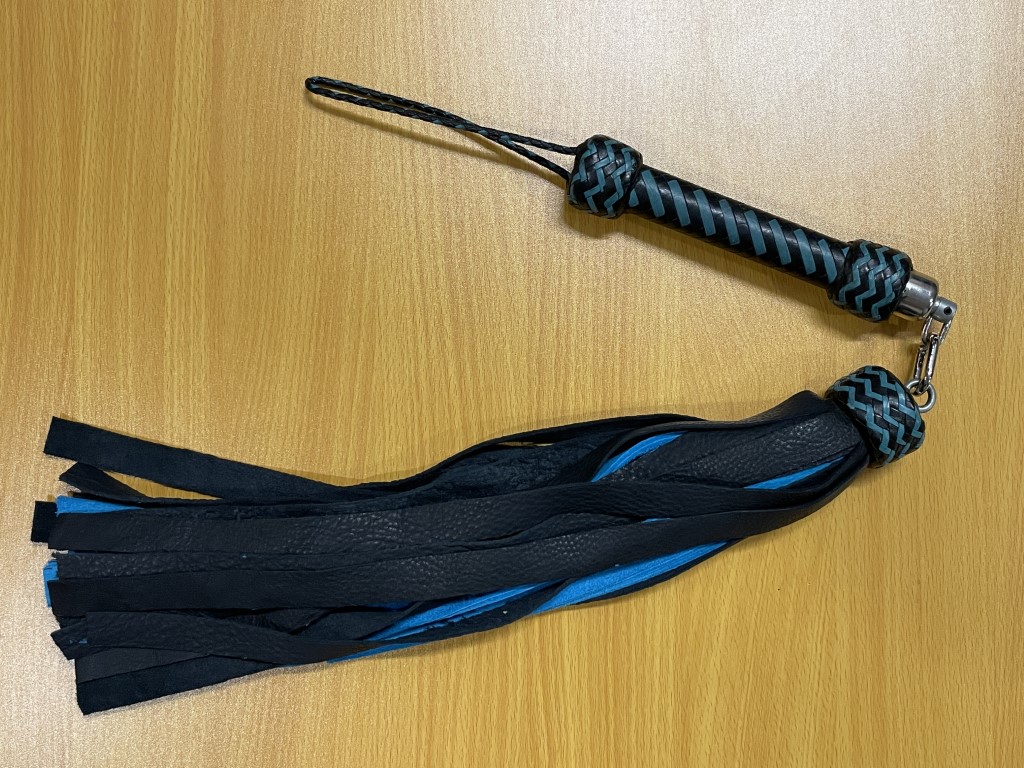
Chain Links
Another feature you’ll find on some floggers is chain links between the finger loops and tails. For maximum power, I like to pair chain finger loops with shorter tails. Shorter tails are less floppy than longer tails, and the chain pushes the flogger’s center of gravity outwards. Put the two together, and I can generate way more momentum and spin way faster and harder than I could with a similar-length flogger that has no chain and longer tails.
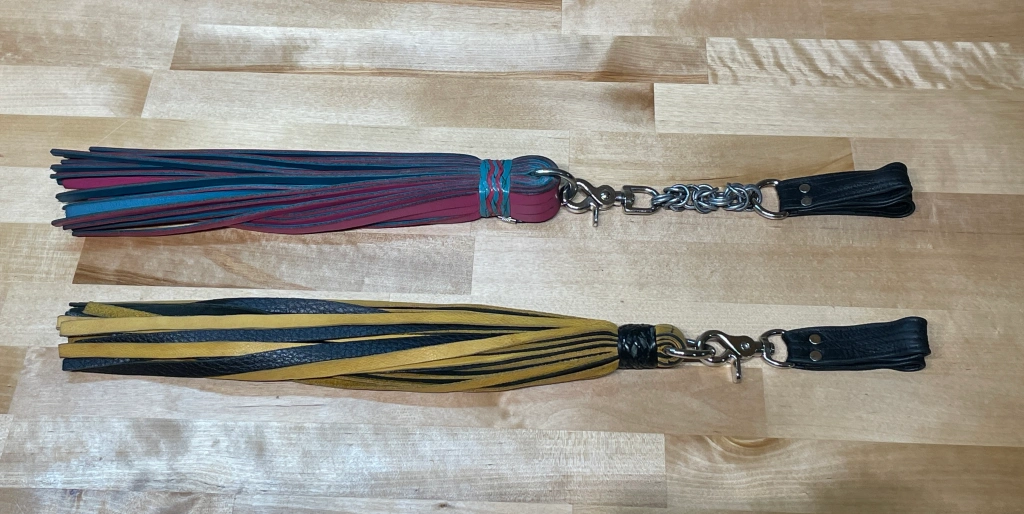
If you’re shopping for a chain finger flogger, take a close look at the quality of the chain itself. As with trigger snaps, do the chain links look like pieces you can find at a hardware store? Are they woven together, with no single points of failure (i.e., if one link breaks, the entire chain will fall apart)? Or does the chain look like a jewelry piece? Because if it’s the latter, there’s an excellent chance it won’t withstand heavy flogging.
Modularity for Versatility
I just spent a considerable number of words talking about the metal hardware you find in floggers. What happens when you put everything together? Well, you end up with an arsenal of finger loops and handles that can be swapped out for a variety of different toys.
Here are three different floggers from three different shops:
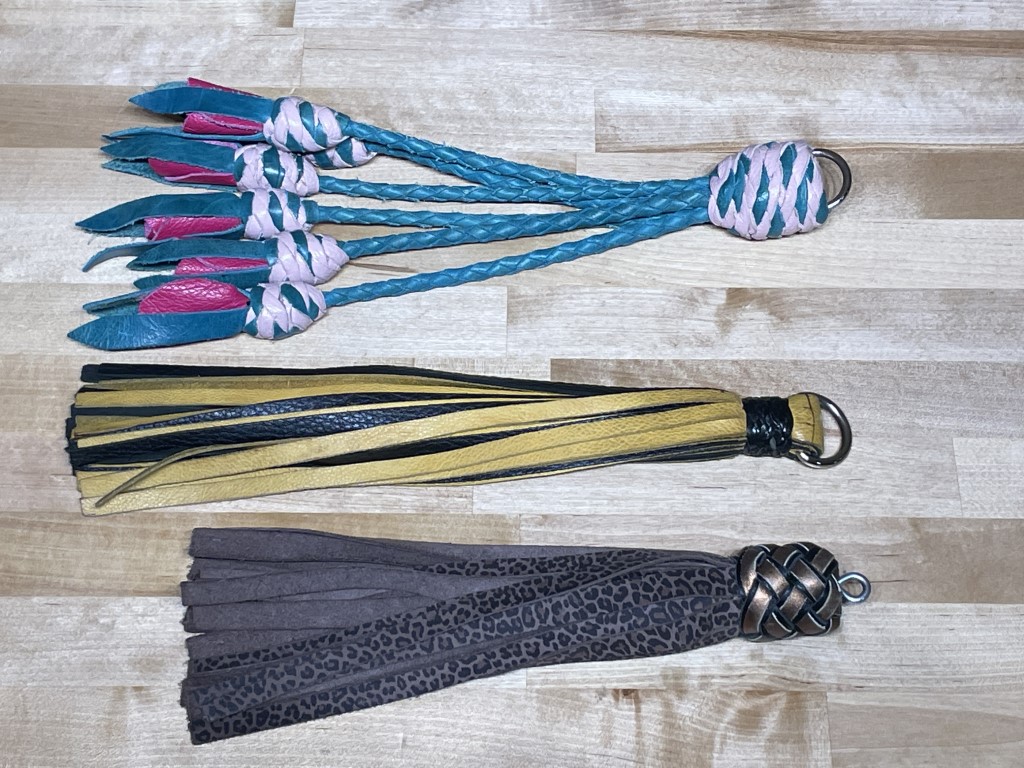
All three can be used with any of these handles or finger loops:

Since all three floggers use the same aforementioned configuration of a ring attached to the tails, I can use a combination of trigger snaps, quick links, and carabiners to attach them to a variety of different handles or finger loops, thereby giving myself a ton of versatility in how I want to use my toys.
When I really want to be mean to my bottom, I’ve even done this:

The way I see it, toys are way more fun when you can swap parts back and forth. With this level of interchangeability, you’ll always have the element of surprise at your disposal and be able to keep your bottoms on their toes (literally). Happy flogging!